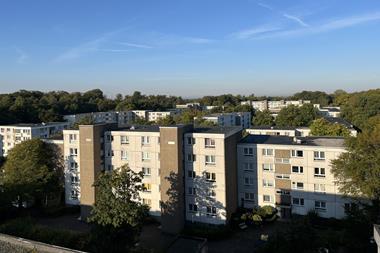Recent falls in the housing market have been spectacular but above average returns keep REITs on top of the pile. And apartment REITs may be set for a bull run. Brad Case reports
Investors worldwide have heard the notes of the Marche funèbre for the US housingmarket. The values of more than 75m single-family houses in the US have declined by 5% on average according to even the most conservative estimates, while the hardest-hit cities - such as Miami, Phoenix, Las Vegas, San Diego, and Los Angeles—have lost more than 28% of their housing wealth.
But house prices are not the whole story in US residential real estate: an important sector of the market - and one to which overseas as well as US investors have easy access - has provided gains of more than 30% annualised so far in 2008. And the music heralding this new bull market in apartment REITs seems to have played only its first theme. Investors in US apartment REITs have just come out of what counts for them as a harrowing experience: from January through December 2007, total returns for the apartment REIT sector were -32%. Do not feel too sorry for them, though: even counting this downturn - extraordinarily severe by REIT standards - the total return on apartment REITs during the five years from July 2003 through July 2008 averaged +15.2% - far better than the broad US stock market (9.1%), large cap US stocks (7.0%), or US bonds (4.6%), and nearly as strong as the booming but volatile market for non-US stocks (15.4%). What explains the crescendo of US apartment REIT returns even while house prices continue to fall? (Actually, if those two parts of the US residential real estate market had moved together, that would have been surprising: since 1993, the correlation between apartment REIT returns and house prices in most US cities has been less than 13%.) There seems to be at least five factors working to pull apartment REIT returns upward.
Housing market problems drive demand for apartments
The bad news on house prices is part of the good news for investors in US apartment REIT stocks. American households are extraordinarily mobile, which means they frequently face the decision whether to buy or rent their next dwelling. With house values widely expected to decline further and mortgage rates uncertain at best, many households prefer to rent - which means more demand for dwelling units owned and managed by apartment REITs.
Operating efficiencies support increased net income
The internet has been an unexpected partner in supporting apartment REIT returns. US apartment REITs have developed sophisticated web portals to market available units, reducing between-tenant vacancies and supporting rents. Independent academic researchers have found that apartment REITs produce much stronger returns at the property level than institutional owners of apartment buildings - a REIT performance advantage that may be explained by superior property management.
Construction costs keep supply down
New apartment construction has been moderate during the past 15 years, in large part because construction costs have been relatively high. High prices for steel and other commodities used heavily in commercial construction kept supply in check even when financing was cheap and plentiful. With the advent of the US credit crisis, constraints on the supply of new construction have been magnified - helping to keep vacancy rates down and rents high.
Inflation concerns prompt a flight to real estate
Real estate has long been recognised as among the most effective inflation hedges, and US investors are increasingly concerned that domestic inflation is increasing dramatically. Apartment REITs have generally been able to pass higher costs on to tenants in the form of annual rent adjustments. Because of this, apartment REITs have historically provided an especially strong hedge for inflation-wary investors.
Market momentum increases upside potential
Finally, part of the outperformance of the apartment sector can be traced to market dynamics. Stock market investors typically overreact in a downturn, driving company values down below the values of their underlying assets. The 2007 downturn hit apartment REITs more severely than any other sector of the US REIT market - suggesting that, for some reason, investors may have overreacted more strongly against apartment REIT stocks than against other REIT stocks. If so, that would explain why the recovery in apartment REIT stock prices started at least two months before other REIT sectors.
The view from here
Nobody can predict the future for apartment REITs or any other investment, but it is helpful to look to the past for a sense of what the future may bring. Each of the previous downturns in the US REIT market - the first in 1989-1990, the second in 1997-1999 - was followed by a bull market with total returns averaging at least 20% for at least seven years. That means the current market may provide investors a golden opportunity to upgrade their investment portfolios. Over the last 30 years, through all three downturns, the total return on US equity REITs has still averaged 13.9% per year - compared to the broad US stock market at 12.4%, US large cap stocks at 12.1%, and non-US stocks at 10.6%. And equity REITs have achieved this outperformance with less volatility: a monthly standard deviation of 3.95%, compared to 4.4% for the broad US stock market, 4.3% for US large cap stocks, and 4.8% for non-US stocks.Most importantly, though, apartment REITs and other equity REITs have been among the most effective assets for constructing a well-performing, diversified portfolio. Since 1993 the correlation between US apartment REIT returns and the broad US stock market has been just 32% - meaning that apartment REITs have been a much more effective portfolio diversifier for US investors than international stocks, with a correlation of 77%. From the perspective of a non-US investor, US apartment REITs are even more valuable: the correlation between apartment REIT returns and non-US stock returns has been just 26%.
Investors worldwide can choose from a varied menu of opportunities to include US investments in their portfolio. While many of the sounds coming from the US are sad - bank liquidity problems, below-target earnings, inflation concerns, and declining house prices - the dirge has long since ended in one segment of the US residential real estate market as REITs take up the melody, vivace.
Brad Case is vice president of research and industry information, NAREIT












